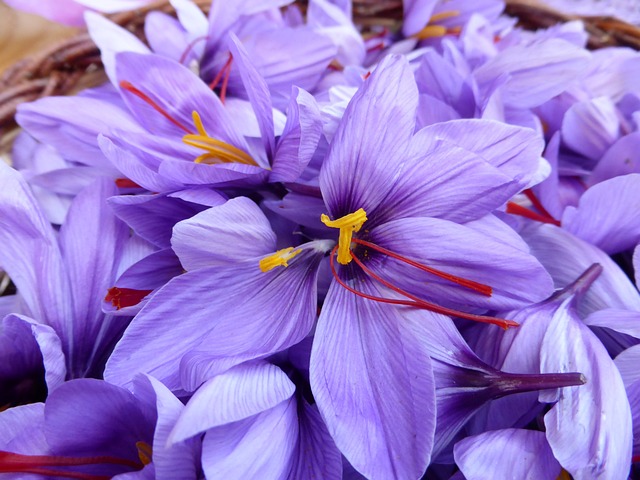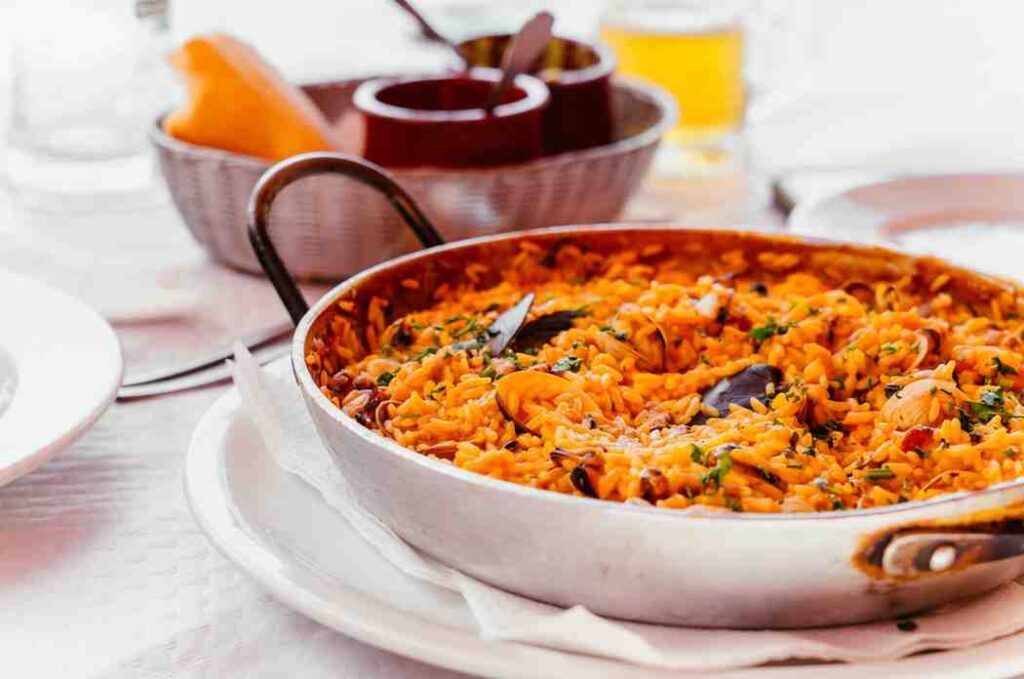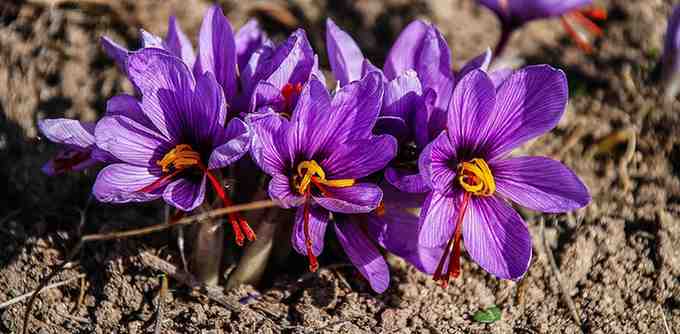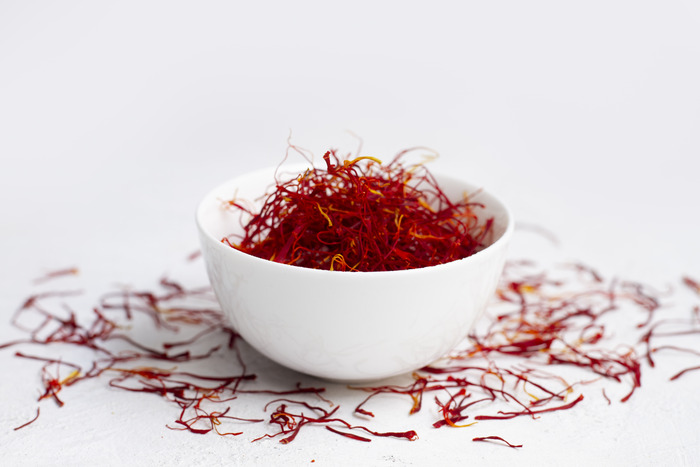Saffron, known scientifically as Crocus sativus, belongs to the Iridaceae family. This perennial plant has striking purple petals and vibrant red stigmas, which workers carefully hand-harvest and dry to produce the saffron spice. Unlike many other plants, Crocus sativus does not produce seeds. Instead, it relies on corms, a type of bulb that grows underground, for propagation.
Humans began cultivating saffron over 3,000 years ago, starting in ancient Persia, now modern-day Iran. Saffron quickly spread across various civilizations, becoming essential in culinary practices, religious rituals, and traditional medicine.
Historical and Archeological Evidence
Saffron’s rich history is well-documented through archeological and historical records:
- Ancient Persia: Persians extensively cultivated saffron, which played a vital role in the local economy and culture.
- Minoan Civilization: Frescoes from the Knossos Palace in Crete depict saffron gatherers, highlighting the spice’s importance in ancient Mediterranean societies.
- Mesopotamia: Ancient texts describe saffron’s use as a therapeutic agent, showcasing its early medicinal applications.
These findings show that saffron was not just a valuable trade commodity but also a cultural and medicinal treasure across different eras and regions.
Ethnobotany and Cultural Significance of Saffron
Saffron in Ancient Cultures

Saffron’s influence extends beyond its economic value. It has deep roots in the cultural practices of many civilizations. In ancient Egypt, people revered saffron for its role in religious rituals and embalming processes. Egyptians believed saffron had divine properties, making it essential for preserving mummies and honoring the dead.
In ancient Greece, saffron was closely associated with the goddess Eos, the personification of dawn. The vibrant color of saffron symbolized the rays of the morning sun, making it a staple in rituals dedicated to the goddess. Additionally, Greek elites used saffron as a dye for their garments, reflecting its status as a luxurious item.
Saffron in Rituals and Religion
Throughout history, saffron has played a pivotal role in religious and spiritual practices across various cultures:
- Hinduism:
- Saffron, considered sacred, is widely used in religious ceremonies, weddings, and festivals.
- People often mix saffron with water to create a paste, which they then apply to religious icons and deities as an offering.
- It also colors and flavors the prasadam (food offering) given to devotees in temples.
- Buddhism:
- Buddhist monks traditionally dye their robes with saffron, a practice dating back thousands of years.
- Saffron-dyed robes symbolize purity, renunciation, and the quest for enlightenment, which are core principles of the Buddhist faith.
Medicinal Use in Traditional Practices
For centuries, people have recognized and utilized saffron’s medicinal properties in traditional medicine systems. In Ayurveda, India’s ancient system of medicine, saffron, known as “Kesar,” is used to treat a wide range of ailments:
- Respiratory Issues: Saffron relieves symptoms of asthma and other respiratory disorders.
- Digestive Disorders: Ayurvedic practitioners recommend saffron for treating indigestion and improving appetite.
- Vitality Enhancement: Saffron is considered an aphrodisiac and is used to boost vitality and overall well-being.
In Traditional Chinese Medicine (TCM), saffron, known as “Fan Hong Hua,” invigorates the blood, resolves stagnation, and alleviates pain. TCM practitioners use saffron to treat conditions such as menstrual disorders, abdominal pain, and traumatic injuries. The spice also enhances mood, making it a valuable remedy for depression and anxiety.
The Active Components of Saffron: A Chemical Goldmine
Saffron’s unique properties come from its rich array of bioactive compounds, including crocin, picrocrocin, and safranal. These compounds give saffron its vibrant color, distinct flavor, and characteristic aroma.
Key Bioactive Compounds
- Crocin:
- Crocin, a carotenoid, gives saffron its deep orange-red color.
- It acts as a powerful antioxidant, protecting cells from damage caused by free radicals.
- Research suggests crocin may offer anti-cancer properties, neuroprotective effects, and cognitive benefits.
- Picrocrocin:
- Picrocrocin, the glycoside precursor of safranal, gives saffron its characteristic bitter taste.
- Studies show picrocrocin has mood-enhancing properties, which help alleviate symptoms of depression and anxiety.
- Additionally, it may offer cognitive benefits, potentially serving as a natural remedy for age-related cognitive decline.
- Safranal:
- Safranal, a volatile oil, is responsible for saffron’s distinctive aroma.
- It forms during the drying process of saffron.
- Safranal exhibits neuroprotective, anticonvulsant, and antidepressant effects.
Ancient Remedies Meet Modern Science
Modern science has validated many traditional uses of saffron. Research shows that saffron effectively treats conditions such as depression, anxiety, and Alzheimer’s disease. Its antioxidant and anti-inflammatory properties also make it valuable for preventing and treating chronic diseases, including cancer and cardiovascular conditions.
Saffron in Modern Medicine
Contemporary medicine continues to explore saffron’s therapeutic potential. Clinical studies have shown that saffron extract may be as effective as certain pharmaceutical antidepressants, with fewer side effects. Additionally, saffron is being researched as a natural remedy for menstrual discomfort, insomnia, and even weight management. As research progresses, saffron’s role in modern medicine will likely expand.
Culinary Use of Saffron Through the Ages

Saffron in Ancient Cuisine
Saffron has a rich history in culinary traditions, dating back to ancient times. In Persia, saffron was a staple in royal kitchens, where it flavored and colored rice dishes. The Romans also prized saffron, incorporating it into their wines and sauces. During medieval times in Europe, saffron became a key ingredient in elite kitchens, enhancing the flavor and appearance of various dishes.
Saffron in Modern Cooking
Today, saffron remains a beloved ingredient in kitchens worldwide. Its unique ability to add both color and flavor makes it a versatile spice that chefs and home cooks highly value. Saffron is particularly prominent in Mediterranean, Middle Eastern, and South Asian cuisines.
Popular Dishes Featuring Saffron
- Paella (Spain):
- Paella, a traditional Spanish dish, is known for its rich flavors and vibrant color.
- Saffron is a key ingredient, giving the dish its golden hue and distinctive taste.
- Risotto alla Milanese (Italy):
- Risotto alla Milanese is a creamy rice dish from Milan, where saffron takes center stage.
- The spice enhances the dish’s rich, earthy flavor and gives it a vibrant yellow color.
- Bouillabaisse (France):
- Bouillabaisse, a traditional fish stew from Provence, relies on saffron for its subtle, aromatic depth.
- Saffron complements the seafood flavors, elevating the dish to gourmet status.
- Biryani (South Asia):
- Biryani, a complex, layered rice dish, combines fragrant basmati rice with marinated meats, vegetables, and a blend of spices like cinnamon, cloves, and ginger. These spices create a warm, aromatic base that enhances the flavor of the dish, making it a beloved favorite across many cultures.
- Saffron is often dissolved in warm milk and drizzled over the rice, adding a luxurious aroma and color.
Saffron in Regional Cuisines
- Iran – The Heartland of Saffron Production:
- Iran produces over 90% of the world’s saffron.
- Saffron is deeply embedded in Iranian cuisine, with dishes like “Tahdig” (crispy rice) and “Sholeh Zard” (saffron rice pudding) showcasing its versatility.
- In Persian culture, saffron symbolizes wealth, beauty, and hospitality.
- India – Saffron in Sweet and Savory Creations:
- In India, saffron enhances the flavor and appearance of a wide range of dishes, from “Kesar Pista Kulfi” (saffron and pistachio ice cream) to “Rogan Josh” (spicy lamb curry).
- Saffron symbolizes purity and good fortune in religious rituals.
- Indian traditional medicine, particularly Ayurveda, uses saffron for its healing properties.
- Middle Eastern Cuisine – Saffron in Feasts and Festivities:
- Saffron is a key ingredient in Middle Eastern dishes such as “Kabsa” (a spiced rice and meat dish) and “Baklava” (a sweet pastry).
- The spice is often reserved for special occasions, symbolizing wealth and hospitality.
- Several Middle Eastern cultures celebrate saffron during harvest festivals, featuring traditional music, dance, and food.
Spain – A Legacy of Saffron in Everyday Cooking
Culinary Tradition: Saffron is a key ingredient in Spanish cuisine, especially in famous dishes like “Paella” and “Fabada Asturiana” (a bean and sausage stew). These dishes clearly highlight how saffron can add bright color and rich flavor.
Cultural Impact: Moreover, the role of saffron in Spanish cuisine reflects its deep cultural roots, which trace back to the time of the Moors. Today, saffron stands as a symbol of Spanish heritage, playing a vital part in both daily meals and special celebrations.

The Economic and Cultural Impact of Saffron
The Role of Saffron in Global Trade
A High-Value Commodity
Harvesting saffron is labor-intensive, making it one of the world’s most expensive spices. Each step, from hand-picking the tiny stigmas to carefully drying and packaging them, requires significant attention to detail.
Historical Trade Routes
Once a prized commodity on the Silk Road, this spice was widely traded across Asia, the Middle East, and Europe. Alongside cinnamon, nutmeg, vanilla, and ginger, saffron played a key role in the economic exchanges of these regions.
Modern Trade
Today, saffron remains a luxury item in high demand, particularly in the food and pharmaceutical industries. Its applications have expanded beyond traditional recipes, increasing its value in various sectors.
Saffron’s Influence in Art and Literature
Artistic Appeal
Throughout history, artists and writers have celebrated the vibrant hue and unique properties of saffron. Its bright yellow color has inspired creativity and symbolized luxury.
Poetic Symbolism
Ancient Greek and Roman poets often used saffron as a metaphor for beauty, luxury, and divine favor in their writings, further cementing its cultural significance.
Medieval European Art
During medieval times, saffron was prized for its ability to produce brilliant yellow pigments. Artists used it to add a golden glow to both religious and secular works of art, valuing its long-lasting quality.
Cultural Festivals Celebrating the Spice
Spain’s Festival in Consuegra
The town of Consuegra holds an annual saffron festival, celebrating the harvest and processing of this important crop. This event highlights the spice’s impact on the local economy.
India’s Harvest Celebrations in Kashmir
In Kashmir, the saffron harvest brings communities together with traditional music, dance, and food. These events honor the cultural significance of this spice and the labor-intensive work of local farmers.
Iran’s Saffron Heritage Festivals
In Iran, festivals celebrating this spice’s long history feature traditional harvesting demonstrations, cultural performances, and cooking exhibitions. These events showcase the central role saffron plays in Persian culture.
The Future of Saffron: Challenges and Opportunities
Sustainability and Ethical Practices
Environmental Challenges
As demand for saffron increases, so do concerns about sustainable production. Climate change, soil degradation, and water shortages pose significant threats to its cultivation.
Fair Trade and Ethical Sourcing
Fair trade practices are becoming increasingly important in the spice trade. Ensuring fair wages for farmers helps maintain the quality and availability of this valuable crop while promoting ethical production.
Prospects for Growth
As global interest in natural remedies rises, saffron’s role in both the food and health industries is expanding. Innovations in sustainable farming will be key to meeting growing demand in the future.
Saffron in Contemporary Culture
Cultural Importance
Deeply rooted in various traditions, this spice continues to symbolize luxury, beauty, and tradition. Its use in religious ceremonies and cultural festivals around the world remains significant today.
Culinary Significance
Chefs around the world treasure saffron for its vibrant color and unique flavor. It enhances a variety of dishes, from traditional meals to innovative culinary creations in modern kitchens.
Research in Medicine
Ongoing studies into the health benefits of this spice suggest its potential in treating conditions such as depression, anxiety, and Alzheimer’s disease. As research progresses, saffron may become a vital component in natural health therapies.

